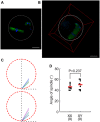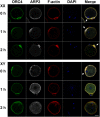A lack of coordination between sister-chromatids segregation and cytokinesis in the oocytes of B6.YTIR (XY) sex-reversed female mice
- PMID: 28424461
- PMCID: PMC5430445
- DOI: 10.1038/s41598-017-00922-1
A lack of coordination between sister-chromatids segregation and cytokinesis in the oocytes of B6.YTIR (XY) sex-reversed female mice
Abstract
The B6.YTIR (XY) mouse develops bilateral ovaries despite the expression of the testis-determining gene Sry during gonadal differentiation. We reported that the oocytes of the XY female are defective in their cytoplasm, resulting in a failure in the second meiotic division after activation or fertilization in vitro. However, the mechanism of meiotic failure or the cause of infertility remained to be clarified. In the present study, we obtained mature oocytes from XY females by superovulation and confirmed that these oocytes also fail in zygotic development. By using confocal microscopy 3D-analysis, we demonstrated that meiotic spindles were properly positioned and oriented in the MII-oocytes from XY females. After parthenogenic activation, fewer oocytes from XY females extruded the second polar body, and in those oocytes, sister-chromatids were often separated but neither set entered the second polar body. ARP2, F-actin, and ORC4, known to play roles in asymmetric meiotic division, were initially localized along the ooplasmic membrane and concentrated over the MII-spindle but lost their cortical polarity after activation while the sister-chromatids moved away from the oolemma in the oocytes from XY females. Our results indicate that the second polar body extrusion is uncoupled from the sister-chromatids separation in the oocytes from XY female mouse.
Conflict of interest statement
The authors declare that they have no competing interests.
Figures







Similar articles
-
Both nuclear and cytoplasmic components are defective in oocytes of the B6.Y(TIR) sex-reversed female mouse.Dev Biol. 2000 Mar 15;219(2):277-86. doi: 10.1006/dbio.1999.9600. Dev Biol. 2000. PMID: 10694422
-
The presence of X- and Y-chromosomes in oocytes leads to impairment in the progression of the second meiotic division.Dev Biol. 2007 Jan 1;301(1):1-13. doi: 10.1016/j.ydbio.2006.10.034. Epub 2006 Oct 27. Dev Biol. 2007. PMID: 17123505
-
The behavior of the X- and Y-chromosomes in the oocyte during meiotic prophase in the B6.Y(TIR)sex-reversed mouse ovary.Reproduction. 2008 Feb;135(2):241-52. doi: 10.1530/REP-07-0383. Reproduction. 2008. PMID: 18239052
-
Functions of actin in mouse oocytes at a glance.J Cell Sci. 2018 Nov 22;131(22):jcs218099. doi: 10.1242/jcs.218099. J Cell Sci. 2018. PMID: 30467138 Review.
-
Spindle formation, chromosome segregation and the spindle checkpoint in mammalian oocytes and susceptibility to meiotic error.Mutat Res. 2008 Mar 12;651(1-2):14-29. doi: 10.1016/j.mrgentox.2007.10.015. Epub 2007 Nov 9. Mutat Res. 2008. PMID: 18096427 Review.
Cited by
-
Tenuous Transcriptional Threshold of Human Sex Determination. I. SRY and Swyer Syndrome at the Edge of Ambiguity.Front Endocrinol (Lausanne). 2022 Jul 26;13:945030. doi: 10.3389/fendo.2022.945030. eCollection 2022. Front Endocrinol (Lausanne). 2022. PMID: 35957822 Free PMC article.
-
Effects of the Sex Chromosome Complement, XX, XO, or XY, on the Transcriptome and Development of Mouse Oocytes During Follicular Growth.Front Genet. 2021 Dec 20;12:792604. doi: 10.3389/fgene.2021.792604. eCollection 2021. Front Genet. 2021. PMID: 34987552 Free PMC article.
References
-
- Lovell-Badge R, Robertson E. XY female mice resulting from a heritable mutation in the primary testis-determining gene. Tdy. Development. 1990;109:635–646. - PubMed
Publication types
MeSH terms
Substances
Grants and funding
LinkOut - more resources
Full Text Sources
Other Literature Sources

